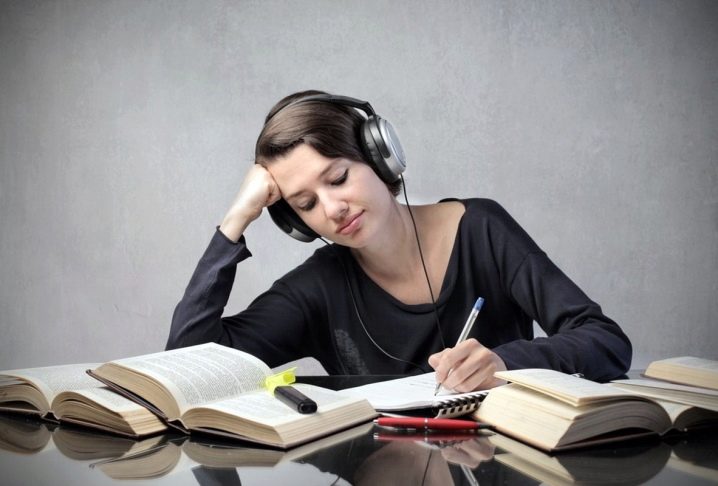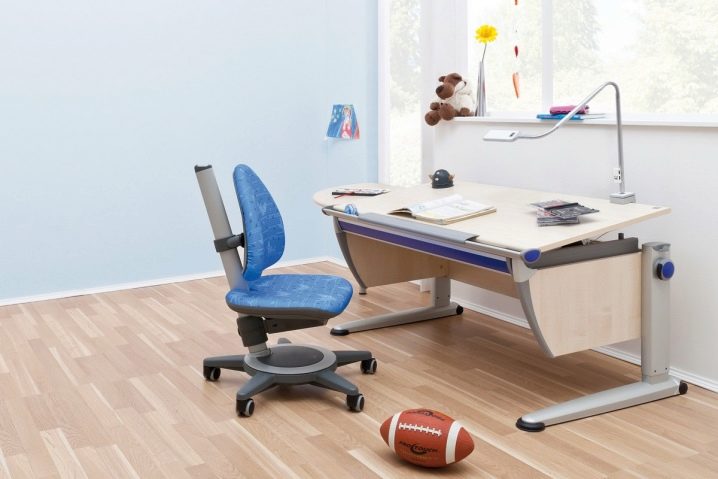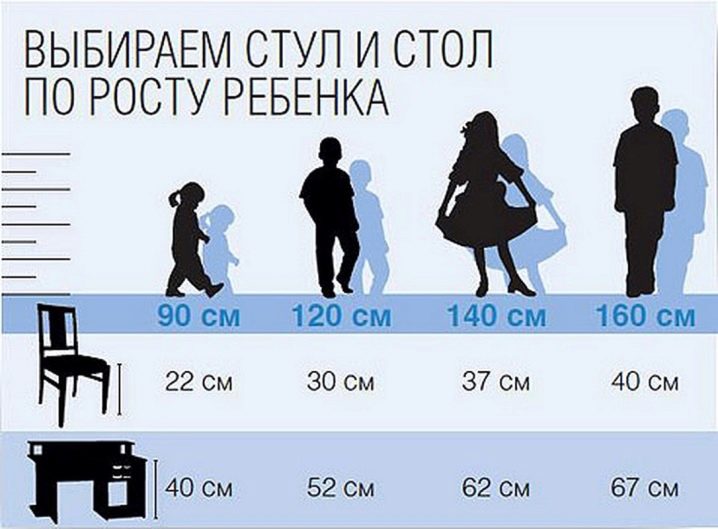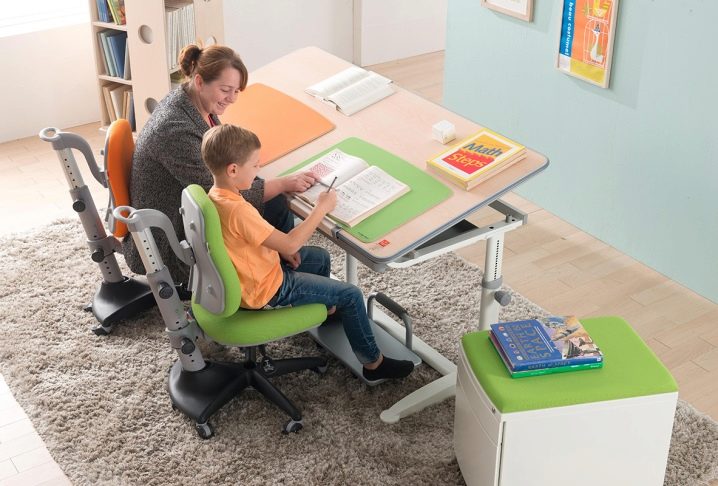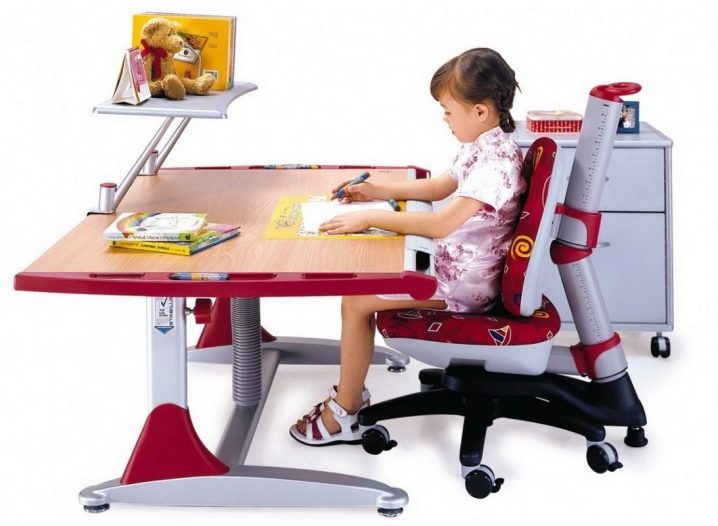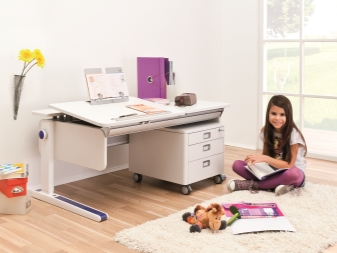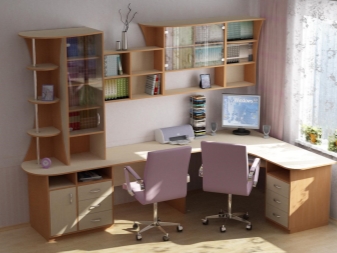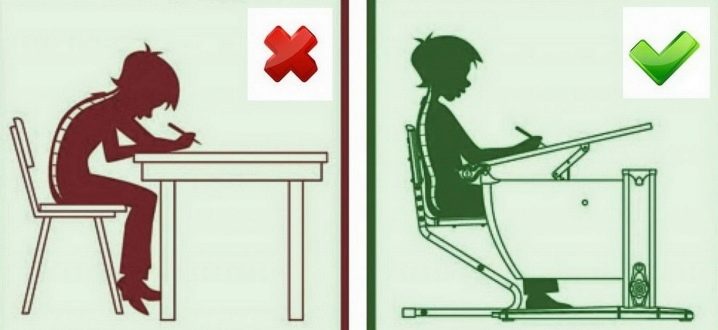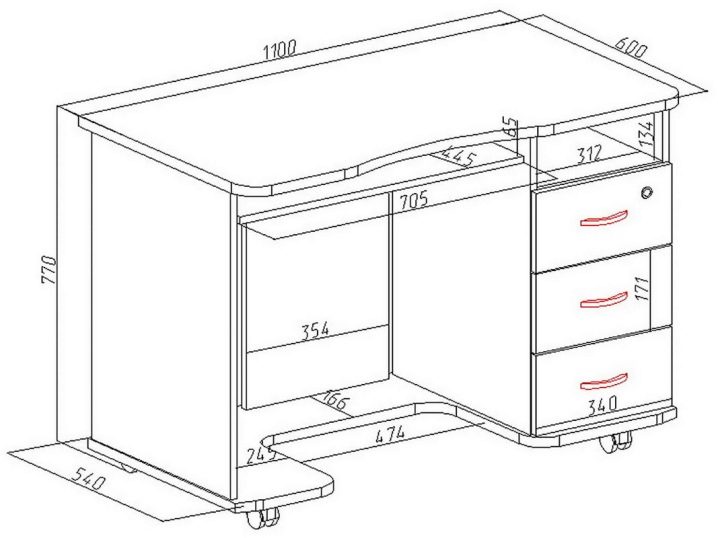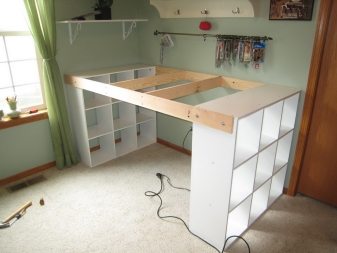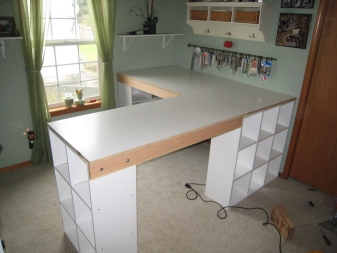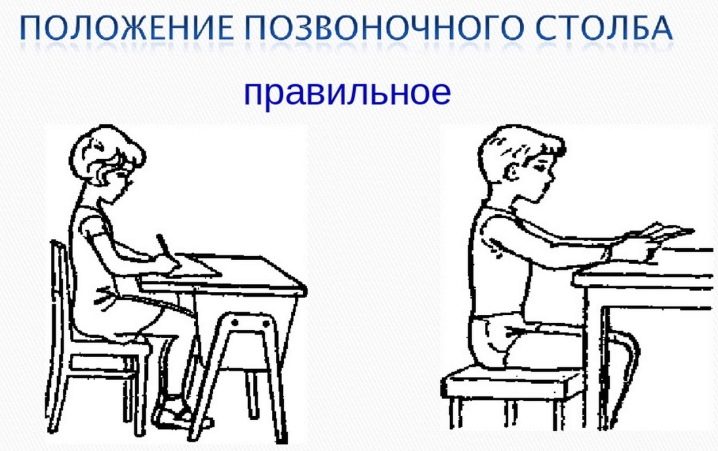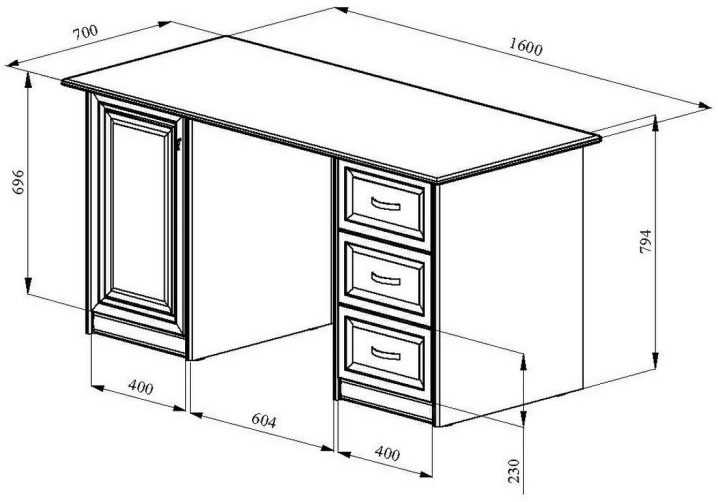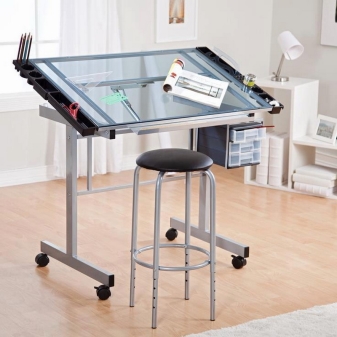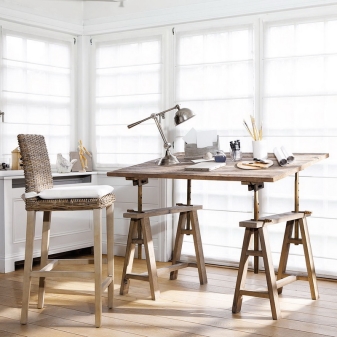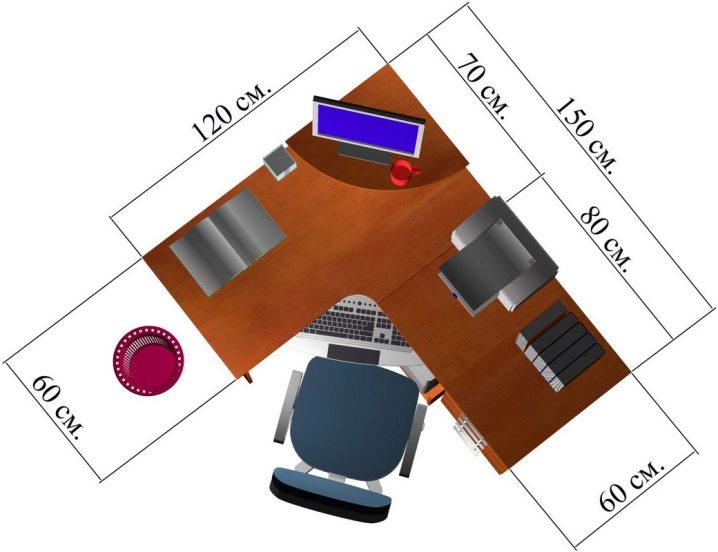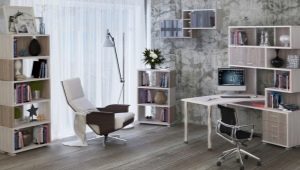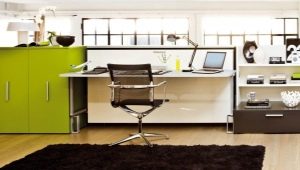Sizes of writing desks
Even the era of total information cannot completely eliminate the need for handwriting. In the next 10 - 30 years, this certainly will not happen. That is why it is very important to know how to choose the right desk, what its dimensions should be.
Features of the school desk
This piece of furniture is purchased most often for students in school - and one should take the choice very seriously from the very beginning. After all, he has to serve for many years, from entering the first class until the graduation work in a professional school, ideally. The size of the desks should be determined not only by the size of the room and personal tastes, but also by medical considerations.
According to statistics, the overwhelming majority of cases of spinal curvature and its other disorders in childhood and adolescence are associated with an incorrect fit. Orthopedists recommend focusing on indicators such as:
- width - not less than a meter;
- depth - at least 0.6 meters;
- Arm room - 50 to 50 centimeters.
Considering the fact that the child and the teenager are continuously growing, a desk with adjustable height and inclination is much preferable to the usual option.
Age parameters and individual choice
In most cases, you can take as a basis the following figures:
- with the growth of 1 m 10 cm - 1 m 15 cm the edge of the tabletop and the floor should be separated by 46 centimeters;
- 1 m 15 cm - 1 m 30 cm imply an optimum of 52 cm;
- height 130 - 145 centimeters best compatible with height 58 cm;
- for children from 145 to 160 cm, tables 63 centimeters high are desirable;
- with an increase from 160 to 174 cm inclusive, the distance to the floor should be 70 centimeters;
- and for those grown up to 175 centimeters and above, only 76-centimeter tables are suitable as a minimum.
It is easy to see that a rare family will be able to allocate enough funds to buy new furniture on time. Therefore, from the very beginning, it is worth investing a little more money in the built-in model, and then no longer worry about the wallet or the health of your child.
Any specialist - both a doctor and a representative of the furniture industry, will tell you that the dimensions are a purely individual matter, and the above figures are only indicative, averaged. Therefore it will be more correct joint visit to a specialty store.
When the student is sitting at the table straight and in a comfortable position for work, the tabletop must be parallel to the solar plexus. Make sure that you do not have to push your legs or pull them to the limit on the ground, that the feet are set flat on the floor and do not hang in the air even just a little bit.
Functionality is above all (except health)
They always write at the table, not on it. It follows that you will always have to fold notebooks and notebooks, individual sheets and felt-tip pens, pens and pencils, compasses and pencil cases, textbooks and diaries, and some other things too. All of them need to be able to get there quickly, without going somewhere to the other end of the room. Because the standard of choice of a desk requires to consider it functionality.
A single nightstand that comes bundled may not be enough to accommodate everything you need. As a result, both on the table and in the vault itself there is inevitably chaos. When there are two cabinets, it is easy to decompose stationery and educational literature, but another problem arises - there is no place to put your feet. Then do not be surprised, again, spoiled posture.
But additional or add-on modules allow for a balance between convenience and safety of use. The shape of the table in the form of the letter G makes it possible to combine work at a computer and preparation for schoolwork in one place - but not in any room there will be enough space for such furniture.
A one-piece set costs more, but it allows you to place both the main workplace and accessories for work, as well as various minor things, household items.
More about using the desk
Its standard dimensions should allow it to freely and naturally take this posture:
- legs fully supported on the floor (full foot, without interruption);
- hands on the surface of the table;
- back, strictly parallel to the back of the chair and not coming off from it;
- from the edge of the table top to the solar plexus of the person sitting there should be a gap in which you can put the palm quietly.
Do it yourself
Many in order to save decide to make a desk on their own. In this case, the possibilities are limited, and it will not be possible, for example, to prepare a system for changing the height. It cannot be done properly in artisanal conditions.We'll have to limit the classic unchanged size - 110x60 centimeters.
Safe can be considered a table whose corners are cut down to 2x2 cm, after which they are rounded off with sandpaper. The protrusion of the tabletop should be 20 centimeters, which means that a reinforcing bar 20x45 is required.
In order for a self-made table to be not only reliable, but also functional, it is desirable to equip it with a pair of canisters.
To do this, take the sidewall 160 by 40 centimeters, the front upper lobes of which are rounded using the 2x2 corner angle, and the lower rear ones are washed down with a 4.5x5.5 baseboard. To make the shelves convenient to use, their internal dimensions should be 400x350 millimeters. Four of the five shelves are fastened with screws on the sides, and for the fifth use special mounts. Then they cut out the back upper plank and fix it on the screws.
Note that the width and depth of the space under the tabletop can not be less than 50 centimeters each, otherwise it will not be very convenient to use it. The typical size of the table top is 0.7 meters, and its height is 0.76 meters. Focusing on these parameters, you will be able to provide the student with the opportunity to read, read and do mathematical calculations calmly and freely.
Take into account the computers, printers, scanners and other accessories that will have to be placed on the table. This is important in any case, and when you do it yourself, and when you choose in the store.
Note that from the eyes of the person sitting to the monitor should always remain at least 60 centimeters.
When the hand is lowered, between its elbow and the bottom edge of the tabletop the optimal distance is 5 cm. If the seated student puts his hands in front of him on the table, there should be no unnatural tension in the shoulders.
How to choose a desk for the child, see the following video.
The table is not for the student
The need to read and read at the table comes not only from those who study at school, university or college. Such a need may arise from accountants and secretaries, managers and translators, proofreaders and teachers. Yes, every person needs to write from time to time - at least to fill in receipts for utilities, while working with documents at the table is much more convenient and comfortable than without him.
For adults, the minimum size of the desk is:
- in height - 75-80 centimeters;
- at least 0.7 meters in length;
- on the width of the table top from 0.35 to 0.6 meters.
But these are the smallest indicators. Write a letter, read a newspaper (book, magazine) or sign a contract - this is its limit, in fact. Architects and designers, engineers and designers, artists and other people who are constantly working with large sheets of paper, it is better to buy a table at least 1.2 meters in length and 0.7 meters in width. A useful feature is the tilting of the tabletop, thanks to him, working with drawings, drawings, diagrams and sketches will be much more convenient.
Optimal distances from the eyes of workers to monitors, written texts, and so on (no matter whether they are adults or children) are calculated on the assumption that the angle of view is from 0 to 30 degrees, while the neck does not tilt back or forward .
Russian GOST provides that office desks with adjustable height should be regulated from 68 to 80 centimeters, and with unchangeable - strictly 72.5 centimeters. The depth of the working surface is set at 60 (80) cm and 120 (160) cm at a minimum, respectively. The presence of sharp edges and corners is unacceptable.The leg niche under the office table should be no lower than 60 and no longer 50 centimeters, in depth - 0.45 meters at the level of the knees and 0.65 m with the legs extended.
Rectangular desks without a dedicated front edge should be 160 cm wide and 80 centimeters deep. This is enough to work calmly with texts and occasionally with a laptop, if the need arises.

